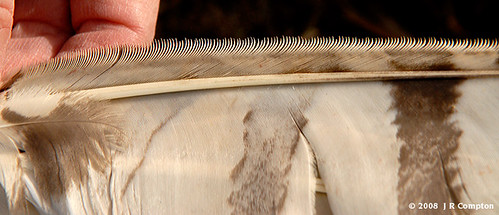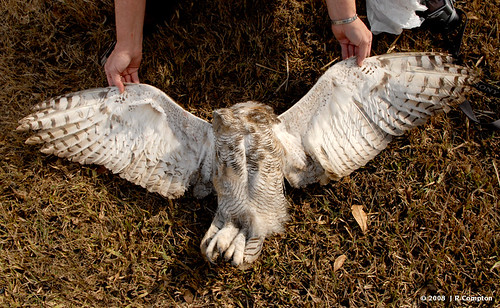tags: Great Horned Owl, Tiger Owl, Bubo virginianus, birds, mystery bird, bird ID quiz
[Mystery bird] Great Horned Owl, also known as the Tiger Owl, Bubo virginianus, photographed on the roadside in the Edinburg, Texas in The Lower Rio Grande Valley. This valley occurs at the boundary between the United States and Mexico. [I will identify this bird for you in 48 hours]
Image: ©JRCompton.com/birds: JR Compton, 2008. I encourage you to purchase photographs from this photographer. [larger view].
Please name at least one field mark that supports your identification.
One of my goals for the mystery birds series has been to teach you how to "see" birds. To meet this goal, I have been wishing to run a series of "bird body parts" photographs where I show you a photograph of a specific body part of a bird and ask you to tell me about it. This is the first of what I hope will be a series of mystery birds body parts where I show you a close-up of a body part every Friday and ask you to tell me about why that body part evolved to look the way it does. In this case, you are looking at a feather, so I want you to answer as many of these questions as you can (speculation is most welcome!):
- Where is this feather located on the bird?
- What does this feather's asymmetrical shape suggest about its function?
- What feature makes this feather special?
- What does this special feature do for the bird?
- What taxonomic group of birds shares this special feature?
- Can you name this species?
This is a flight feather located on the bird's left wing.
Asymmetrical feathers evolved for flight.
It has a "comb" on the leading edge -- the edge that faces oncoming air.
This curled edge is adapted to breaking up the wind generated when the bird flies, thereby silencing the bird's flight.
Owls.
Another photograph of the same bird:
Great Horned Owl's 44-inch Wingspread.
Great Horned Owl, also known as the Tiger Owl, Bubo virginianus, photographed on the roadside in the Edinburg, Texas in The Lower Rio Grande Valley. This valley occurs at the boundary between the United States and Mexico.
Image: ©JRCompton.com/birds: JR Compton, 2008. I encourage you to purchase photographs from this photographer.



Pure speculation--
leading edge wing feather of an owl--breaks up the airflow, acting as a flight silencer. From the color, perhaps a barn owl?
1) it's a wing feather
2) I think it's place in the front of the wing
3) those little barbs suggest that it makes the flight noiseless
4) it's easier to approach it's prey
5) this must be some kind of owl
6) this I don't know.
 6.  One of those guys who tries to fly by flapping artificial wings with his arms.
I'd agree with everything above, except I'm wondering if it could be a Barred Owl rather than a Barn Owl. The striping looks more like Barred Owl feathers I've seen, but I don't have a barn owl feather handy for comparison, so I'm not quite sure.
I share Jana's doubt over the Barn Owl ID; it looks too gray. The bars don't look bold enough for a Barred Owl, so I'm voting for that other big owl.
The previous posters made good points, and it may well be an owl. But I am going with the white-tailed hawk based on coloration and shape.
I'd agree with the questions answered so far, and would go with 6) Barn owl, but I have to admit that's just due to the coloration.
That said, with the hand in the picture the size of the feather looks a bit on the small side. Then again, I've never had one in my hand so it's hard to compare. =)
In order:
1. This is a primary, and although we normally think of them as 'leading edge', in fact when you look at a wing, only the outermost primary forms the leading edge -- the rest of the primaries fan out behind the hand.
2. Assymetrical feathers like this imply that the feather is involved in flapping flight -- when the wing comes down, the feather twists so that the 'lift' that it is generating is oriented forwards, providing thrust as well. A symmetrical feather would have similar forces acting on each half, so wouldn't twist (consistently, at least).
3, 4, 5. Good call, Slim.
6. I have my doubts about barn owl as well, it seems it should be whiter, and Barred Owl generally doesn't reach the valley, so I'll go with the N. Am. Eagle Owl.
I found a website new to me (though you guys might already know of it) - the national wildlife forensic lab's Feather Atlas. It's having some issues at the moment, but before it kicked me out, I looked at both Barn Owls and Barred Owls - I don't think it's either. Barn owl stripes generally don't go across the entire trailing/posterior portion of the feather, they taper off in the middle. And Carel's right - Barreds are typically a stronger bar than seen here. I didn't have a chance to check any other raptors.
http://www.lab.fws.gov/featheratlas/browse.php
4. I'm just going to add to Slim's idea, and say that not only is it easier to approach prey, but it's easier for the owls to hear their prey as well. With silent flight, their own wingbeats won't interfere with the sound of the prey, and as they mainly hunt by sound, that's pretty important.
6. I'm going to throw out Great Horned Owl, Bubo virginianus. I'm afraid I don't have any field marks for it, it just seems like a GHOW feather to me.
This supports the barred owl theory.